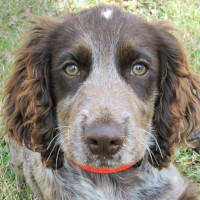Appearance of the German Shorthair Toller
|
| The German Shorthair Toller will be a combination of the two parent breeds, the elegant German Shorthaired Pointer and the magnificent Nova Scotia Retriever. The coat of this beautiful hybrid varies in color and can include liver and a combination of liver and white like the Pointer parent. The Toller parent is often red or orange, and as the Pointer parent can also be red, this is a color that can be seen. The coat may be reddened or ticked, or may have the white markings on feet, chest, tail tip and face seen in the Toller dog. Your German Shorthair Toller will be medium-sized and solid-boned. It has a deep chest and sturdy legs. This hybrid may have high triangular ears or ears that fall to the sides of the face. Teeth are well defined, eyes are brown and the nose can match the coat. |
Temperament of the German Shorthair Toller
|
| The German Shorthair Toller is intelligent and eager to please its owner. They are easy to live with, although they can sometimes be reserved. They can develop separation anxiety if left alone for long hours at a time. Although he's a big dog, he's most definitely a house dog and is very devoted to his family. He will be very unhappy if left outside in the yard or in a kennel. He is an assiduous hunter who can also be playful when not hunting. Tolling is a natural trait, born in the Toller parent, which makes it invaluable to its hunting partner. They are excellent dogs with children and often have much more patience with children than other hybrids. They are not good watchdogs, but will bark to alert you to something out of the ordinary. Owners must be pack leaders and must not abuse their authority over the dog. |
Needs and activities of the German Shorthair Toller
|
| The German Shorthair Toller is a fairly active dog. It is recommended that he gets enough exercise to ensure he maintains a healthy weight. He may tend to put on weight if not exposed to regular activity. He'll do best in a home with a large yard in which he can be allowed to run and play, but if he's kept in an apartment, plenty of exercise is a must. He may also enjoy joining you for a leisurely stroll. The dog park is an ideal place for the German Shorthair Toller, as he'll appreciate the opportunity to get out, run and play with other dogs. He needs regular exercise to avoid excessive chewing. He may tend to chew or be destructive if not properly exercised. Some experts recommend two hours of exercise in order to bear the German Shorthair Toller's ills. It's important to remember that the German Shorthair Toller does best with plenty of room to play and a space of its own inside your home. |
Maintenance of the German Shorthair Toller
|
| The German Shorthair Toller has a short, thick, water-repellent coat that will most likely have a dense undercoat. It may be slightly longer under the tail and hips, and the hair on the head may be softer and shorter. This hybrid's coat should be easy to maintain, as it does not shed excessively. Brush it with a pincushion brush once a week. Bathe only when necessary, or risk losing the natural oils that help keep the coat naturally soft and shiny. It's also important to check his feet if he's been hunting to make sure they're in perfect condition. Check for cuts or cracks and keep nails trimmed to a good length. If your dog loves water and you take him swimming often, be sure to check that his ears aren't too wet, which could lead to the formation of yeast or bacteria. Keep his teeth clean by brushing them a few times a week. |









 English (United Kingdom)
English (United Kingdom)